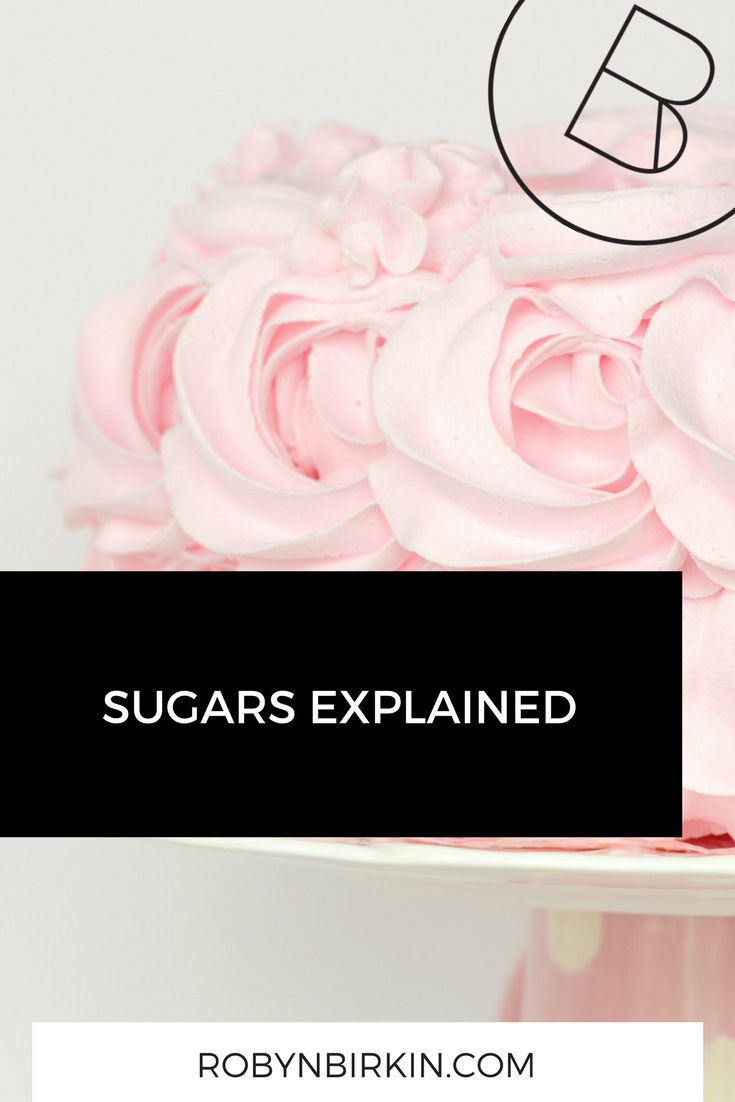Is is just me or is sugar on everyone’s lips these days?
There are many wonderful posts out there about sugars but I always find that they just don’t explain everything I want to know about sugars, all in one place. In preparing this article though, the one thing I’ve learned is that holy cow, there is so much to know about sugars and so so so many different sweeteners out there. So, here is the stuff I think you NEED to know about sugar with a handy table at the bottom for comparisons:
How the Glycemic Index Matters…
High GI = 70+
Mid GI = 56-69
Low GI = <55
The GI (Glycemic Index) level of foods is a way of measuring the effect foods have on your blood sugar level. A high GI food will give you a rapid spike in energy (often followed by a low), whereas a low GI food will give you a more sustained release of energy.
Quite often with sweeteners, you’ll find that low GI sweeteners have a higher fructose content, whereas high GI sweeteners have a higher glucose content.
Why everyone hates high fructose corn syrup (HFCS)
Table sugar and HFCS are both very similar in chemical composition – they’re about a 50/50 mix of fructose and glucose and, as with all sugars, have 17
The sugars in table sugar are chemically bonded together, so the body must first digest it, break the bonds and then the energy is released into the body. In HFCS on the other hand these sugars are just blended together, so they can start to have a party in your body straight away.
So, everyone’s like nooooooooooo because the theory is that this impacts the production of insulin, leptin, ghrelin and all sorts of other things like appetite regulation and how full you feel after a meal. But, many studies have shown that they aren’t actually really any different to one another.
My sugar philosophy
One of the reasons I don’t post many sweet recipes on my blog is because I have the belief that sweet things are best consumed minimally.
It takes about three weeks for your taste buds to change, and I find that if I am in the habit of eating sweet things, then I want more sweet things, whereas if I eat a mostly savoury diet (and steer clear of refined carbohydrates), then I don’t really crave those things and I feel better for it.
My exception to this rule: fruit such as apples and berries. Two serves of fruit a day is a good thing.
When you’re considering what sugars to use, I think that minimally processed ones are best, and then aside from that, I worry too much about it, because I know that I’m only consuming a small amount.
The sugars I use most regularly are medjool dates (how else do you make bliss balls?), agave syrup (for when I want something to replace honey – as a vegan I don’t eat honey), maple syrup (probably my favourite sweetener and perfect on pancakes and for something like a quinoa breakfast porridge) and coconut sugar for when I need a dry sugar – these last me a long time, and are only used sparingly, like on weekends.
We also have in our house raw sugar (because my husband insists on having it in his coffee), brown rice sugar which I just don’t get around to using because I don’t have sweet things so often, and backstrap molasses (I want to use this because it really does have good levels of vitamins and minerals, but like brown rice syrup, I just don’t get around to using it).
Sugars Explained
Dry Sugars
| Sugar | GI | About |
| White sugar | 68 | White sugar is pressed and uses an evaporation process like many other sugars, to form crystals, however sulphur dioxide is used to bleach them, and then various other chemicals such as phosphoric acid and carbon hydroxide soak up impurities like mould, soil etc. It is then filtered through carbon or bone char (the bones of animals) to remove the molasses.The resulting product is pretty much devoid of any nutrients. |
| Raw sugar | 65 | The sugar cane is pressed and mixed with lime, and then forms crystals through evaporation and by passing it through a centrifuge. It has a darker colour than other sugar because of the minute presence of molasses… and also because it hasn’t been bleached! |
| Brown sugar | 64 | Brown sugar is made in the same way as white sugar, but after everything is done, they add a teeny bit of molasses back in and then dry again. |
| Dates | 42 | Dates are a fruit. Sometimes you buy them dried or fresh as medjool dates. Dates are high in fibre, and also provide a small amount of vitamins and minerals such as iron, magnesium, vitamin B6 and manganese. |
| Coconut sugar | 35 | This comes from the sap of the coconut plant (not to be confused with palm sugar which comes from a different type of palm tree). Coconut sugar has trace amounts of minerals like iron, zinc, calcium and potassium, as well as some antioxidants and inulin (a type of fibre) which may slow glucose absorption. It is about 35-45% fructose. |
| Rapadura sugar | 65 | Rapadura comes from cooking the juice that has been pressed from sugarcane until it is very concentrated, then drying and granulated it. Because it has been processed really naturally, rapadura still contains any of the vitamins that would normally be found in sugarcane. Like molasses, it has a dark, caramel-type flavour so goes well in baked goods. Rapadura sugar is about half glucose and half fructose. |
| Stevia | 0 | It is about 200-300 times sweeter than regular sugar (I’ve never tasted it but apparently it has a taste that takes some getting used to). It comes from a plant in Paraguay. |
| Sucanat | 55 | This stands for sugar cane natural and is very similar to rapadura sugar and contains 100% of the sugar cane’s molasses (making it about 13% molasses) |
| Mesquite Powder | 25 | Mesquite powder comes from the seeds of the mesquite plant and has a nutty, caramel flavour. It’s higher in protein and has levels of calcium, magnesium, potassium and iron. The main sugar in mesquite powder is fructose |
Wet Sugars
| Sugar | GI | About |
| Maple syrup | 54 | Maple syrup comes from the sap of maple trees and has a caramel-type taste. In the shops look out for organic maple syrup, as some brands just mix together corn syrup and other stuff to fake maple syrup. The only ingredient should be maple syrup. Not as high as molasses, but does contain a number of minerals. Mostly sucrose. |
| Agave syrup | 15 | Made from the sap of agaves (a cactus plant). It tastes similar to honey but is 1.5 times sweeter. Agave syrup is a little bit controversial because it has a very high fructose content (more than high fructose corn syrup).It is a about 70-90% fructose.Some agave is heavily processed to look out for the ones that aren’t. |
| Backstrap Molasses | 55 | Unlike most sweeteners, this contains a dose of vitamins and minerals, including calcium, magnesium, potassium and iron.Molasses is the leftovers from processing sugarcane (they boil, cool and then remove the crystals). Backstrap molasses comes from the third boiling.Try to buy organic as any pesticides are likely to be more concentrated.It has a strong flavour. |
| Brown Rice Syrup | 25 | This is made when white rice is cooked, and the starches broken down. The resulting liquid is then cooked down to thick syrup. It isn’t as sweet as white sugar. It is composed of 50% complex carbohydrates, which means less of a spike in blood sugar levels, however because it is mostly maltose, it is not recommended for diabetics, as it can still cause spikes in blood sugar.In case you were wondering, it is called brown rice syrup because of the colour it imparts. |
| Yacon Syrup | 1 | Yacon syrup comes from the roots of the yacon plant and is basically formed in the same way as other sugars (heated and evaporated until a thick syrup forms). It has a caramel-type taste. Yacon Syrup was featured on the Dr Oz show not so long ago because apparently it speeds up your metabolism because (long story short) it contains a type of sugar called FOS, which can’t be broken down when consumed, so it reaches your colon unaffected and feeds all of your good bacteria, thus allowing them to do their thang! I looked all over the internet to find something against this, and didn’t have much luck, but all I can think is that they say “when something seems to good to be true, it usually is”. I’m not going to recommend eating bucket loads of this… |
For comparisons to other GI levels:
- Honey: 62
- High Fructose Corn Syrup: 100
- Glucose: 100
- Orange Juice: 46
- Banana: 51
- Apple Sauce: 35
Well, that was certainly an interesting experience, and I hope that clears things up (it certainly did in my head!). What sugars do you use? What is your sugar philosophy? Is there something else I need to cover?

